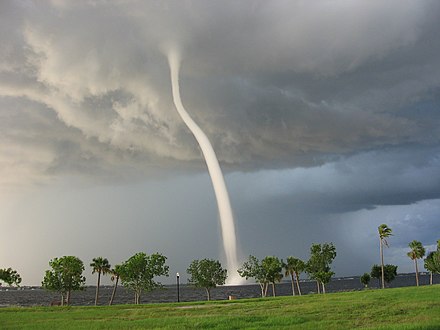A waterspout is an intense columnar vortex(usually appearing as a funnel-shaped cloud) that occurs over a body of water, connected to a cumuliform cloud. In the common form, it is a non-supercell tornado over water.[1] While it is often weaker than most of its land counterparts, stronger versions spawned bymesocyclones do occur.[2][3] Waterspouts do not suck up water; the water seen in the main funnel cloud is actually water droplets formed by condensation.[4] While many waterspouts form in the tropics, other areas also report waterspouts, including Europe, New Zealand, the Great Lakes and Antarctica.[5][6] Although rare, waterspouts have been observed in connection with lake-effect snowprecipitation bands.
Waterspouts have a five-part life cycle: formation of a dark spot on the water surface, spiral pattern on the water surface, formation of a spray ring, development of the visible condensation funnel, and ultimately decay.
Types of waterspout
Waterspouts that are not associated with a rotating updraft of a supercell thunderstormare known as "non-tornadic" or "fair-weather waterspouts", and are by far the most common type. Fair-weather waterspouts occur in coastal waters and are associated with dark, flat-bottomed, developing convective cumulus towers. Waterspouts of this type rapidly develop and dissipate, having life cycles shorter than 20 minutes.[7]They usually rate no higher than EF0 on theEnhanced Fujita scale, generally exhibiting winds of less than 30 m/s (67 mph).[8] They are most frequently seen in tropical and sub-tropical climates, with upwards of 400 per year observed in the Florida Keys.[9] They typically move slowly, if at all, since the cloud they are attached to is horizontally static, being formed by vertical convective actioninstead of the subduction/adduction interaction between colliding fronts.[9][10] Fair-weather waterspouts are very similar in both appearance and mechanics to landspouts, and largely behave as such if they move ashore.[9]
Tornadic
"Tornadic waterspouts", also accurately referred to as "tornadoes over water", are formed from mesocyclonic action in a manner essentially identical to traditional land-based tornadoes in connection with severe thunderstorms, but simply occurring over water.[11] A tornado which travels from land to a body of water would also be considered a tornadic waterspout.[12] Since the vast majority of mesocyclonic thunderstorms occur in land-locked areas of the United States, true tornadic waterspouts are correspondingly rarer than their fair-weather counterparts in that country. However, in some areas, such as the Adriatic, Aegean andIonian seas, tornadic waterspouts can make up half of the total number.[13]
Snowspout
A winter waterspout, also known as a snow devil, an icespout, an ice devil, a snonado, or a snowspout, is an extremely rare instance of a waterspout forming under the base of asnow squall.[14][15] The term "winter waterspout" is used to differentiate between the common warm season waterspout and this rare winter season event. Very little is known about this phenomenon and only six known pictures of this event exist to date, four of which were taken in Ontario, Canada. There are a couple of critical criteria for the formation of a winter waterspout. Very cold temperatures need to be present over a body of water warm enough to produce fogresembling steam above the water's surface. Like the more efficient lake-effect snowevents, winds focusing down the axis of long lakes enhance wind convergence and likely enhance their development.[16]



No comments:
Post a Comment